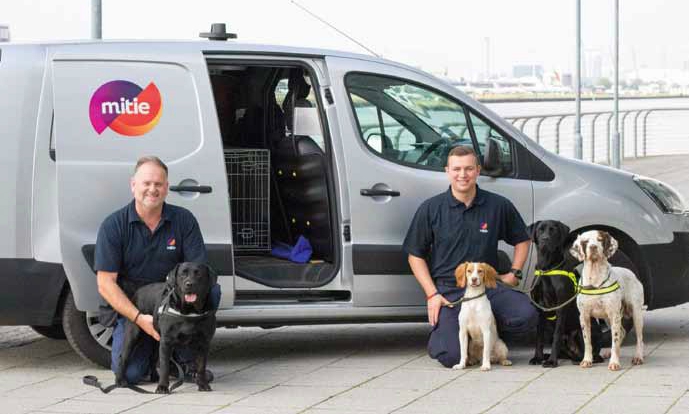John Austin of Mitie discusses the advantages of using sniffer dogs for bed bug detection in college and university residences.
The common bed bug or Cimex Lectularius – is a pest by any other name. Bed bugs are notoriously difficult to locate. An infestation of bed bugs on campus can be extremely distressing for students affected and cause anxiety for staff who have to manage and contain the outbreak. Bed bugs can conceal themselves in hard to see and reach hiding places, setting a challenge for pest detection and control by humans. However, when your pest detector is a highly trained sniffer dog, the task becomes much easier and more efficient.
Conventionally, pest controllers have had to depend on their human senses to detect clues left by bed bugs – faeces, the bugs themselves, and their odour – which is a feint, sickly unpleasant smell. However, a dog has a sense of smell up to typically one million times more powerful than a human. A dog specifically trained to detect bed bugs, will be extraordinarily accurate in discovering them. A dog interprets the world predominantly by smell, whereas human predominantly by sight. A human has about 5 million scent glands whereas dogs have 125 million to 300 million, which is why their sense of smell is so much better than humans.
Virtually invisible but virtually everywhere
The bed bug is one of the most cunning adversaries of the pest controller. Common bed bugs feed on human blood or other warm-blooded animals and grow to about 5mm long when mature. Their oval, flattened brown bodies provide the ideal shape and hue to hide in dark places. They don’tjust ‘live’ in beds and bedclothes.
They can hide behind skirting boards, panels and wallpaper, under carpets, cracks in the floor, in electrical sockets and voids. Bed bugs can even live in birds’ nests and should your campus be surrounded by a number of nesting birds, be alert. Students on campus often have the reputation of being messy and not always exercising regular hygiene habits. With that in mind the assumption is that these factors would prove a primary attraction for bed bugs. This is not the case. Bed bugs can easily be picked up by students at any other facility such as hostels, lodges, shared houses and other student accommodation where bed bugs are present, so even for the most fastidious residences or facilities, there is no escape if the bedbugs move in.
Once they have a foothold in your premises, somewhere they are undisturbed, comfortable and easily fed, they stay there until they hitch a ride somewhere else – either on you or on your personal belongings. It’s that easy. In colleges and universities, often with a substantial portion of international and exchange alumni, bed bugs can ‘travel’ regularly in suitcases domestically or internationally, hidden among the clothes. It’s an impressive survival mechanism and that’s why we often hear about hotels being infested – because hotels are perfect bed bug travel hubs.
Unfortunately, the bed bug is an unpleasant souvenir from your travels – especially if you bring them home. Being that ‘invisible’ and mobile means that you don’t realise that bed bugs are there until the tell-tale signs appear. Their faecal smears on the bed clothes give them away. Of course the top indications of their presence are unpleasant signs on a resident’s body such as itchy welts caused from their bites.
Ahead of the game by a nose
At Mitie, we realised that the traditional methods of bed bug detection had its disadvantages on several fronts. Depending on human eyesight to visually detect such a discreet pest was not reliable. Furthermore, the ‘blanket’ approach to extermination is not environmentally friendly or safe to immediate occupants of the infested space. Staff and students shouldn’t be potentially exposed to unnecessarily high volumes of toxic pesticide. Imagine the chaos of a suspected bed bug infestation at the beginning of term and a large volume of rooms are unusable because they are doused in pesticide – when in fact not all of them have to be.
We decided to invest our efforts in streamlining the bed bug (and rodent) detection process for pest management. Sniffer dogs can detect bed bug infestations quickly and accurately, allowing for timely and targeted treatment to eradicate the pests. Not only are sniffer dogs able to identify and locate active infestations, they ignore the old infestations and focus on live active ones. Furthermore, Mitie’s dogs are trained to specifically detect only bed bugs so that they do not provide false confirmations.
The use of sniffer dogs adds yet another commercial advantage. Because they are able to quickly identify pest activity, this is well suited to auditing large premises with several rooms, just like the campus environment. In so doing, they are also able to verify very quickly if a previous pest treatment has been effective or not and if a claimed report of bed bugs is genuine or not. A campus facilities manager who has already invested substantially in previous pest eradication or control should know if the money was well spent or not.
As universities and colleges welcome more students each year on their campuses, facilities managers are continuously compelled to find more efficient and safe service solutions. The sniffer dogs’ fast and accurate detection rates mean that pests can be dealt with efficiently, with safer and more focused use of pesticides. There’s less down time involved when treating rooms, campus residents don’t have to be inconvenienced and less costs are incurred because of reduced use of pesticides and manpower time.
When it comes to pest management, timeliness is of the essence because persistent bed bug infestation can ruin reputations, businesses, be litigious and even cause property damage. So, before the situation turns from bad to worse, turn to man’s best friend to teach you some new lessons on pest control.
For more information visit www.mitie.com


